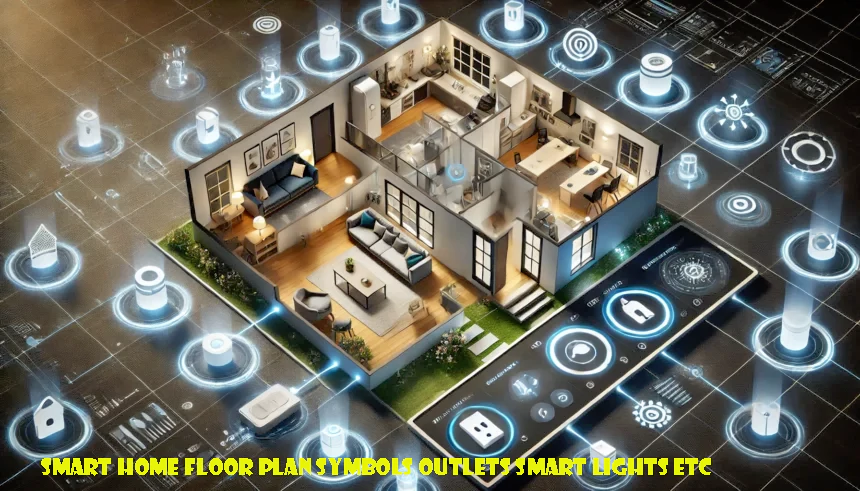A smart home integrates technology to improve convenience, security, and energy efficiency. Understanding smart home floor plan symbols is essential for proper installation and organization. These symbols represent outlets, smart lights, security systems, thermostats, motion sensors, and other connected devices in home layouts.
Using smart home floor plan symbols outlets smart lights etc in a floor plan helps homeowners, electricians, and designers place devices efficiently. A well-planned smart home ensures seamless automation, better energy savings, and enhanced security.
Understanding Smart Home Floor Plan Symbols
Smart home floor plans use unique symbols to represent various devices. These symbols help in planning the structure of a smart home system by indicating the location of outlets, lighting, and security devices.
Each smart device has a different icon or symbol that makes it easier to identify on the blueprint. For example, a small power plug icon represents smart outlets, while a bulb symbol indicates smart lighting.
Placing these symbols correctly ensures better functionality and accessibility. Electricians use these symbols to install devices in the best locations based on power availability and user needs.
Another advantage is that these symbols help in future expansions. If you plan to add new devices later, a well-marked floor plan will guide proper placement.
Smart Outlets and Their Floor Plan Symbols
Smart outlets allow homeowners to control appliances remotely. In floor plans, they are represented as small squares or circles with a power plug symbol. These outlets can be operated through mobile apps or voice commands.
There are different types of smart outlets. Some come with Wi-Fi connectivity for remote control, while others have energy monitoring features that track power usage. Some advanced outlets can also work with schedules, automatically turning devices on or off.
The placement of smart outlets is crucial for convenience. They are often placed near entertainment centers, kitchen counters, and workspaces. Smart outlets near the bed or sofa allow easy charging of devices without needing to reach power switches.
Smart outlets also improve energy efficiency by turning off unused devices. For example, you can set a timer for your TV or heater to shut off at a specific time, reducing unnecessary energy consumption.
Smart Lights and Their Floor Plan Symbols
Smart lights are an essential part of modern home automation. They appear in floor plans as bulb icons or lamp symbols. These lights can be controlled using voice commands, mobile apps, or automation schedules.
There are multiple types of smart lighting, including smart bulbs, LED strips, and smart switches. Some lights offer color-changing options to set different moods, while others have motion detection to turn on automatically when someone enters a room.
Placement of smart lighting symbols depends on the home’s design. Smart bulbs are often used in living rooms, bedrooms, and home offices, while motion-activated lights work well in hallways and outdoor areas for security.
A major benefit of smart lights is their energy efficiency. LED smart bulbs consume less power than traditional bulbs and can be dimmed to save energy. Scheduling lights to turn off when not in use further helps reduce electricity bills.
With integration to home assistants like Alexa or Google Home, smart lighting makes it easier to adjust brightness and color settings without manually operating switches.
Motion Sensors and Security Systems
Security is a top priority in any smart home. Motion sensors and security systems are marked in floor plans with wave, radar, or camera icons. These devices detect movement and send alerts to homeowners when unusual activity is detected.
Motion sensors are commonly placed near entry doors, windows, and stairways to monitor movement inside and outside the home. Some sensors also trigger smart lights to turn on when someone enters a room.
Smart security cameras provide 24/7 monitoring and are often placed at front doors, garages, and backyards. They are represented by small camera icons in floor plans. Many smart cameras offer live streaming and motion alerts through mobile apps.
In addition to cameras and motion sensors, smart door locks enhance security. These locks, symbolized by a key or lock icon, allow access through fingerprint scanning, passcodes, or mobile authentication.
A smart security system gives homeowners peace of mind, ensuring their property is monitored even when they are away. Some advanced systems even integrate with law enforcement for instant emergency response.
Smart Thermostats and Their Floor Plan Symbols
Smart thermostats help maintain a comfortable temperature while reducing energy waste. They are represented in floor plans by temperature gauge icons and are usually connected to heating and cooling systems.
These thermostats adjust the temperature based on weather, occupancy, and preset schedules. Some models learn user preferences and automatically optimize heating and cooling.
The best placement for smart thermostats is in central areas like hallways or living rooms. They should not be placed near windows or direct sunlight, as this can cause inaccurate temperature readings.
Many smart thermostats can be controlled remotely using mobile apps, allowing homeowners to adjust settings from anywhere. This feature is useful for reducing energy use when the house is empty.
With voice assistant integration, users can adjust the temperature using simple voice commands. This makes controlling home climate more convenient and efficient.
Smart Home Hubs and Connectivity
A smart home hub connects all devices and allows centralized control. It appears in floor plans as a Wi-Fi or automation icon and serves as the brain of the smart home system.
Popular smart home hubs include Amazon Echo, Google Nest Hub, and Samsung SmartThings. These hubs communicate with various devices, ensuring smooth automation and coordination.
Placing the hub in a central location is important for maximum connectivity. Ideally, it should be near smart lights, security cameras, and major appliances to minimize signal interference.
For large homes, Wi-Fi mesh systems are recommended to extend the coverage of smart devices. In floor plans, these are marked with network signal icons at different locations.
A well-planned network setup ensures all smart devices work efficiently, providing a seamless smart home experience.
Smart Appliances and Their Floor Plan Symbols
Smart appliances are modern versions of home devices that offer automation and remote control features. They are represented in floor plans by appliance icons with Wi-Fi symbols.
Examples of smart appliances include smart refrigerators, ovens, washing machines, and dishwashers. These appliances can be controlled via mobile apps, allowing users to set schedules and receive alerts.
The placement of smart appliances depends on their function. Smart refrigerators and ovens are located in the kitchen, while smart washing machines are placed in laundry rooms. Smart air purifiers and fans are often used in bedrooms and living rooms.
One advantage of smart appliances is their energy efficiency. They can adjust power usage based on real-time data, reducing electricity bills while maintaining functionality.
With voice assistant integration, smart appliances make daily tasks easier. Users can preheat ovens, check fridge contents, or start washing machines using voice commands.
Conclusion
Smart home floor plan symbols make it easier to design and organize a connected home. These symbols represent various devices, including outlets, lights, sensors, security systems, and appliances.
A well-planned smart home improves convenience, security, and energy efficiency. By placing symbols strategically in a floor plan, homeowners can maximize the benefits of automation.
With the increasing popularity of smart homes, understanding these symbols helps in making better decisions for home upgrades and installations. Whether it’s for lighting, security, or climate control, a well-planned smart home setup enhances comfort and efficiency.






